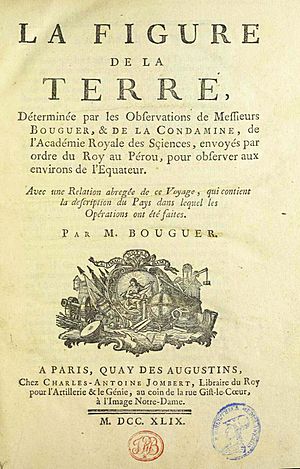Pierre Bouguer facts for kids
Quick facts for kids
Pierre Bouguer
|
|
|---|---|
 |
|
| Born | 10 February 1698 Le Croisic |
| Died | 15 August 1758 Paris |
| Occupation | Hydrographer, explorer, mathematician, physicist, astronomer |
Pierre Bouguer (born February 16, 1698, died August 15, 1758) was a smart French scientist. He was a mathematician, a physicist, and an astronomer. He also studied the Earth's shape and gravity. People often call him "the father of naval architecture." This means he helped create the science of designing and building ships.
Contents
Pierre Bouguer's Amazing Career
Pierre's father, Jean Bouguer, was a top expert in hydrography. This is the science of mapping and describing water bodies. He taught navigation at Le Croisic, France. Pierre learned a lot from his father at home.
In 1714, when Pierre was just 16, he took over his father's teaching job. He became a professor of hydrography. This was a big responsibility for such a young person.
Winning Science Awards
Pierre was very talented. In 1727, he won a major award from the French Academy of Sciences. His paper was about how to best design the masts of ships. He even beat a famous scientist named Leonhard Euler!
He won two more awards that year. One was for finding the best way to measure star heights at sea. This helped sailors figure out their location. The other award was for observing how a compass changes at sea.
Studying Light and the Sun
In 1729, Pierre published a book about light. It was called Essai d'optique sur la gradation de la lumière. In this book, he explained how much light is lost as it travels through the air. He was the first to describe what we now call the Beer-Lambert law. This law helps us understand how light gets weaker when it passes through different materials.
Pierre also made some of the first measurements of light intensity. He found that the sun's light was 300,000 times brighter than the moon's light. This was a huge discovery in the field of photometry, which is the science of measuring light.
In 1730, he became a professor in Le Havre. He also joined the Academy of Sciences. Pierre invented a tool called a heliometer. This device helps measure the sun's diameter. Later, other scientists improved his invention.
Journey to Measure the Earth
In 1735, Pierre Bouguer went on a big scientific trip to Peru. He traveled with another scientist, Charles Marie de La Condamine. Their mission was to measure the length of a degree of latitude near the equator. This helped them figure out the exact shape of the Earth.
They spent ten years on this important project. Pierre wrote a detailed book about their findings in 1749. It was called La figure de la terre, which means "The Figure of the Earth." This book was very important for understanding our planet's shape.
In 1746, Pierre published the first book about naval architecture. It was called Traité du navire. In this book, he explained the idea of the "metacenter." This is a key concept for understanding how stable a ship is in the water. His work helped make ships safer and better designed.
Most of his later writings were about navigation and ship design. In 1750, he was chosen to be a member of the Royal Society in England. This was a great honor for his scientific work.
How Pierre Bouguer is Remembered
Pierre Bouguer's work is still recognized today.
- A crater on Mars is named after him.
- A crater on the Moon also carries his name.
- An asteroid in space is named after him.
Bouguer's Halo and Anomaly
His name is also used for a weather event called Bouguer's halo. You might see this faint, white ring of light in fog when the sun shines through. It's like a "fog bow" and is centered opposite the sun.
The term Bouguer anomaly is also named after him. This refers to small changes in the Earth's gravity. These changes happen because of different rock densities deep underground.
A large bronze statue of Pierre Bouguer stands at the port in his hometown, Le Croisic.
See also
 In Spanish: Pierre Bouguer para niños
In Spanish: Pierre Bouguer para niños
- List of geophysicists
- Radiodrome
- Schiehallion experiment


